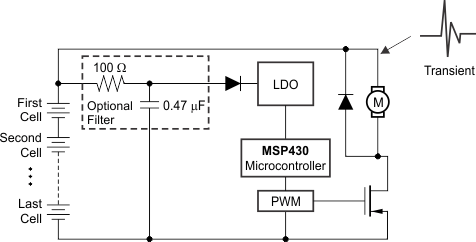ZHCS831E march 2012 – may 2023 TPS7A16-Q1
PRODUCTION DATA
- 1
- 1 特性
- 2 应用
- 3 说明
- 4 Revision History
- 5 Pin Configuration and Functions
- 6 Specifications
- 7 Detailed Description
-
8 Application and Implementation
- 8.1 Application Information
- 8.2 Typical Applications
- 8.3 Power Supply Recommendations
- 8.4 Layout
- 9 Device and Documentation Support
- 10Mechanical, Packaging, and Orderable Information
8.2.4 Battery-Operated Power Tools
High-voltage multicell battery packs support high-power applications (such as power tools) with high current drain when in use, highly intermittent use cycles, and physical separation between battery and motor.
In these applications, a microcontroller or microprocessor controls the motor. This microcontroller must be powered with a low-voltage rail coming from the high-voltage, multicell battery pack; as mentioned previously, powering this microcontroller or microprocessor from an intermediate voltage from the multicell array causes battery-pack life degradation or added system complexity because of cell balancing issues. In addition, this microcontroller or microprocessor must be protected from the high-voltage transients because of the motor inductance.
The TPS7A16-Q1 can be used to power the motor-controlled microcontroller or microprocessor; the device low quiescent current maximizes battery shelf life, and very high-voltage capabilities simplify system complexity by replacing voltage suppression filters, thus lowering system cost.
 Figure 8-7 Low Power Microcontroller
Power From Multicell Battery Packs in Power Tools
Figure 8-7 Low Power Microcontroller
Power From Multicell Battery Packs in Power Tools